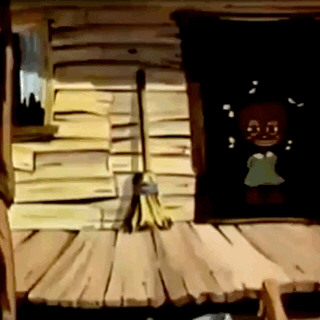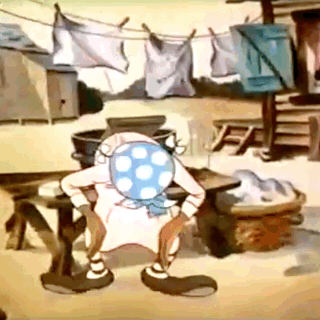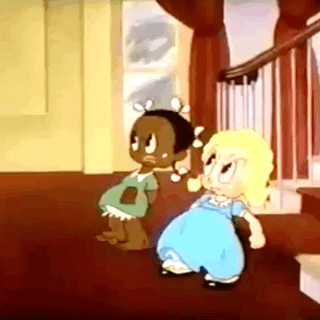Disclaimer: This is the fourth entry in the Censored 11. There are dozens of cartoons not on the list that are just as vile and tasteless, if not more so, yet this provides good insight into what we’re dealing with. With that said, this review entails racist content, imagery, stereotypes, and ideals. I do not in any way endorse these. I find them dehumanizing, gross, and wrong. And to act like they never existed in the first place would be just as insensitive. This needs to be talked about. PLEASE let me know if I say anything wrong. It’s never my intention to harm anyone, and I want my mistakes to be identified so I can own up to them. Thank you for your patience and understanding.
Release date: June 5th, 1937
Series: Merrie Melodies
Director: Tex Avery
Starring: Tedd Pierce (Narrator), Roy Glenn (Uncle Tom), Billy Bletcher (Simon Simon Legree, excited Little Eva), Elvia Allman (Topsy, Eliza), Berneice Hansell (Little Eva), Mel Blanc (Dog), Basin Street Rhythm Boys, The Plantation Choir (Chorus)
This is a rather momentous occasion in Tex Avery’s career, a cartoon that would dictate the direction that the majority of his remaining cartoons at Warner Bros. would take. Uncle Tom’s Bungalow could be loosely considered the first “travelogue” of Avery’s. Especially prevalent throughout 1939 and 1940, Avery did a number of travelogue parodies—a narrator examines a setting as we interact with the characters, narrating what they’re up to, and learning about the area we’re exploring.
This has more of a concrete storyline than many of the other travelogues, thus contributing to its quality, so to speak. Tex would take another spin on Uncle Tom’s Cabin with Uncle Tom’s Cabana in 1947 over at MGM.
And, of course, the elephant in the room—this is Tex’s first entry out of 3 in the Censored 11, the other two being The Isle of Pingo Pongo (1938) and All This and Rabbit Stew (1941). I don’t mean to sound like I’m making light of the impact these cartoons cast—that’s not at all my intention, but there are, undeniably, entries that are better than others. This cartoon is probably the best out of the remaining Avery Censored 11 entries, as well as one of the better entries in the Censored 11 as a whole. That’s not in my power to decide, of course, but in terms of quality, technicalities, and polishing, this is one of the “better” ones.
A parody on the novel by Harriet Beecher Stowe, Uncle Tom’s Bungalow illustrates the story of how Little Eva and Topsy save Uncle Tom, but his refuge is threatened once the girls fall behind on their payments to the treacherous Simon Simon Legree.
The cartoon opens with a long, beautiful pan of the rural countryside, complete with a beautiful, jaunty chorus of “Swanee River”. We truck in on a grandiose property, where we meet our narrator courtesy of Tedd Pierce as he compliments the chorus with “That’s real swing, boys.”
Next starts the first introduction of many, a highlight in the cartoon, if not THE highlight. We’re met with the stereotypical cute little Avery blonde, vocals by the great Berneice Hansell as always. The narrator asks for her name, and, in a moment of greatness, she rambles on in that terminally amusing cutesy voice, giving everything BUT her name. She provides her age, her address, shows off how she can spell “cat” (”I can spell cat! Uh, c-a… uh, cat. Uh…c-a… uh, cat! C-a… well, anyway, I can spell dog! D-o-g, dog…”) and so forth.
As both she and Avery test our patience, she suddenly shows off the lace underneath her dress, getting both the narrator and audience in trouble as the narrator protests, insisting she cover herself back up. “Now, all we want to know is your name!” A Looney Tunes staple, the girl’s outburst is surprisingly provided by Billy Bletcher as opposed to Mel Blanc when she barks “LITTLE EVA, YA DOPE!”
The narrator moves on to patronize his next subject, Topsy. Her introductory gag is seldom spared from being cringeworthy, but is undeniably clever. “Hey, girly. Step out of that shadow and introduce yourself to the folks here.” Topsy makes her way out of the shadows and introduces herself, the narrator once more providing a patronizing chuckle and a “that’s cute.”
Next is Uncle Tom himself, who, surprisingly, isn’t featured very much in this cartoon at all. The narrator comments on how feeble Uncle Tom is getting, remarking on the way his knees shake. Uncle Tom retorts how his knees aren’t shaking–he’s truckin’. Narrator has no response.
Eliza is the next one to be introduced (obligatory “Heeey, that’s MY name!” comment). As grotesque as these caricatures and stereotypes are, Eliza’s banter with the narrator is very amusing. They’re both from the south, and go back and forth in jovial banter about the other being from the south.
Eliza’s animation is very loose, rubbery, and fun, all things considered. Her movements are very reminiscent of Daffy’s exit provided by Bob Clampett in Porky’s Duck Hunt. I don’t believe this is his handiwork—he would have been starting production on Porky’s Badtime Story at about this time, gracing the director’s chair for the first time. Whoever is responsible for this, I don’t know, but from a technical standpoint it’s very well done.
And, of course, every cartoon must have a villain. Meet Simon Simon Legree, who you’ll recognize as the villain from Milk and Money. The name Simon Simon is a take on popular french actress at the time, Simone Simone. Very clever indeed. The animation is top notch as always–in fact, the introductory pieces for every character, gross and cringeworthy as some of the designs are, are very well animated and full of great character acting.
Even the narrator is not immune from puns: “and last but not leashed is the hounds.” The dogs hardly display any signs of enthusiasm as they snooze on the porch–the gray dog troubles himself enough to lift his head up and give a gravelly “Hello.” courtesy of Mel Blanc. That’s that.
The introductory portion, taking up half the cartoon, comes to a close as the narrator asks if all of the characters are ready. They all give the affirmative (perhaps most notably Little Eva responding “You said it, dark, tall, and bow-legged!”, as well as the apathetic dog grunting that there ain’t nothin’ else ta do).
This whole entire scene is far from perfect–stereotypes are abound and caricatures are grotesque, yet this serves as a landmark in Tex’s Warner Bros. career. There isn’t even a fourth wall to break–there is no fourth wall. We are completely immersed with the characters, and the characters are completely immersed with us. They feel real, alive, and with us, all the while holding onto the notion that there is an underlying sense of performance. The most immersive of characters act like they’re putting on a show, coming from an actress herself (I use that coyly—I was in plays and musicals when I was in high school.) Broad movements, exaggerated dialogue. The more unbelievable, the more believable. Cartoon acting is a strange world!
“Here we go, camera!” the narrator announces as a warning. A warning is right. It’s important to remember that this is a parody of the stage adaptations from Harriet Beecher Stowe’s book, not the book itself. Not that a parody makes it okay–it doesn’t. And that’s what we need to remember.
We are greeted with Simon Simon Legree’s slave company, as well as Billy Bletcher’s haunting laugh and Avery’s favorite theme for the villain. Legree cracks his whip, and we are reminded just how treacherous and despicable this man is as we see the whip physically snapping its “fingers”. The next scene is a grotesque and racist (well, that’s a given) display of social commentary as we see slaves lined up against the fence, advertised with signs that liken them to a used car sale. Absolutely brutal, commentary or not. But, again, it must be noted.
Uncle Tom is one of the slaves for sale, who the narrator desperately attempts to warn to escape. Terrible as this sequence is, Uncle Tom provides a great one-liner as Legrer threatens him with his whip. “My body might belong to you, but my soul belongs to Warner Brothers!”
Meanwhile, Little Eva and Topsy hold hands, frolicking and skipping with deliberately annoying singing as they stumble across Legree’s site (as the satirical signs help us remember). They hear the whip cracks, and both girls dart in front of Uncle Tom in an attempt to stop Legree’s abuse. Eva protests “Stop! Stop! We’ll buy the nice old man!”
Very amusing is the next scene as we watch Legree negotiate business deals with two 6 year old children. “Here’s your contract! But remember, if you fall behind in your payments, I take him back!” Thus, the girls take Uncle Tom home, and all is well. For now, anyway. Time marches on as we watch snowdrifts pile on the grandiose property from the beginning, even prompting the narrator to remark “My, my, how time does fly.”
“Looks like bad news, folks,” the narrator ever so helpfully quips as we spot Legree’s business. A wonderfully grotesque hand helps to further the entire sickening feeling that is inherent with legree as he peruses topsy and eva’s checking account: they’re three months behind on their payments. Legree saunters through the snow with that delightfully absurd villain walk as the narrator frets, wishing to warn the kids.
“Jiggers, kids! Ditch Uncle Tom here comes Legree!” With some quick thinking, the girls throw Uncle Tom through the portrait displayed so ornately on the wall. Uncle Tom places his face in the position of the face that was there just seconds before.
I didn’t mention this earlier, but this is Irv Spence’s first scene in a Tex Avery cartoon. Spence is a WONDERFUL animator and one of my favorites. The way his characters move is nothing less than tantalizing. Legree bursts in and berates the kids on Uncle Tom‘s whereabouts. Eva protests “We don’t know, so THERE!”, followed by a “So there!” from Topsy. The way the girls push their bodies, how strong the line of action is, how defined the silhouettes are… absolutely beautiful animation, all things considered. They even make Chuck Jones’ next scene seem inferior, and that’s quite a feat. Legree spits that he’ll find Uncle Tom no matter what, as we see animation of him slithering across the ground, reused from Milk and Money.
He slithers across the floor to where the couch is, per the narrator’s guidance. “Getting warm… warmer… warmer… warmer…”
He’s getting warmer, alright–thanks to the narrator’s quick thinking, Legrer feels around underneath the couch, his fingers dangerously close to an electrical socket. All according to plan as legree is electrocuted, spasming and flailing around in a bright array of colors. As Legree recovers, he does not at all fancy the narrator’s joke of “Bot, you’re burning up!”
More Irv Spence animation as legree threatens to whip the girls within an inch of their lives, until another animator takes over and gives us this take that… speaks for itself how tasteless it is.
Nevertheless, Spence provides animation once more as the narrator recruits Eliza into action. Eliza scoops up the girls and runs out of the mansion, the narrator commentating on the chase like it’s a horse race. Legree whistles, and we are reminded of the lazy dogs from the beginning, who are still snoozing on the porch, covered in snowdrifts. Legree resorts to sniffing out Eliza’s tracks like a dog himself, and in a twist of Tex Avery greatness, one of the footprints kicks legree right in the ass.
The chase persists as Legree now has his hounds, the hounds chasing after eliza. Eliza halts when she approaches a lake: unlike the book, it hasn’t frozen over, no way to cross. Another frequent favorite used by Tashlin, Iwerks, and now Avery as Eliza panics, trying to think of a way to cross. The narrator croons “Relax, Eliza, now don’t get excited, don’t get excited…” Eliza retaliates with the famous “EXCITED?? WHO’S EXCITED?? I’M NOT EXCITED!!!”
As Legree gets closer, the narrator indicates a slot machine–an Avery favorite used since his debut with Gold Diggers of ‘49–where Eliza can get some ice. Eliza slips a coin in, and hits the jackpot. Giant bricks of ice tumble out of the machine, forming stepping stones across the lake. A long shot of Eliza and the girls trying to escape from Legree, who has also approached the ice blocks.
Eliza lands on the shore, as do Legree and the hounds. As the hounds bark at the victims, Legree readying his whip, the narrator giving a dramatic “and the winner…!”, the suspense is broken by the sound of a car horn.
“…is Uncle Tom Looks like the old boy has collected on his social security!” An Avery staple as we see the victorious old man triumphantly holding up his winnings in his grandiose car. A cut gag from Daffy Duck & Egghead also has Daffy crying about how he shouldn’t be killed, he still has to collect on his social security. Definitely a trend in the Avery-verse!
Uncle Tom forks over a bundle of cash to Legree, who accepts it begrudgingly and stalks off. The girls are thrilled. Eva asks “Why, Uncle Tom! Where did you get all that money?”
What better way to end a racist cartoon by perpetuating more stereotypes? Uncle Tom throws two dice on the ground, who land snake eyes. Yet, lo and behold, the dice roll over to reveal a 7. Another Avery iris out gag as the iris closes, leaving the dice on the black screen. The iris opens to allow Uncle Tom to fish the dice back into the cartoon, ending the cartoon as the narrator sardonically croons “...and there you have the story of Uncle Tom’s Bungalow! …or have you?”
I will give this cartoon credit: this is the best entry from the Censored 11 we’ve seen yet. I don’t like to put it like that, because it’s not, and should not be a popularity contest, but the quality of work in this cartoon is undeniably superior in comparison to the other works we’ve seen. I will say that I personally like this better than the previous entry, Clean Pastures, despite its jolly music score.
This cartoon has some wonderful animation by Irv Spence and Chuck Jones, and the entire first introductory half is pretty extraordinary, all things considered. In fact, the rest of the cartoon, in my opinion, doesn’t quite match the momentum brought on by the first half. The first half is slow, yes, but it’s filled with wonderful character acting and animation.
The chase scene between Eliza and Legree doesn’t quite have the same Avery snappiness as other previous chase scenes. It becomes rather droll, despite the narrator’s amusing, if not redundant at times commentary. Frank Tashlin would rival Avery in terms of speed and quality, and that would serve as a great thing–those two would always play off each other as a result, and cartoons got better.
But, with all that said, this is still an abhorrent cartoon in many ways. Stereotypes and caricatures are abound, and scenes are uncomfortable, if not plain cruel at times. Of course historical context is important–one must always keep that in mind–but this still remains as an inexcusable display of racism, even if this is a parody. Racism is racism.
And, because of that, I still can’t recommend this cartoon, or really any of the cartoons on this list. This cartoon is more lighthearted than the previous entries, and I would never call it entirely innocent, but it doesn’t feel as nasty as previous entries like, say, Sunday Go to Meetin’ Time. This cartoon has quality, but it also has many, many problems.
So, as always, I will provide a link–obviously view at your own discretion.














No comments:
Post a Comment